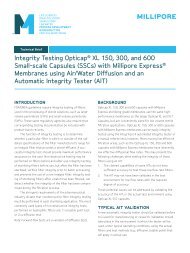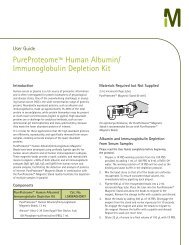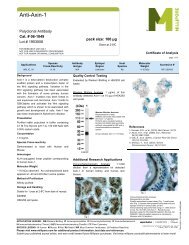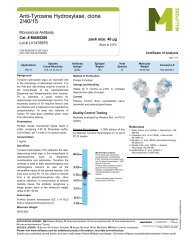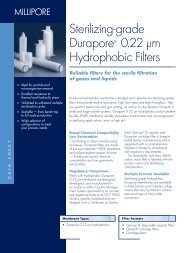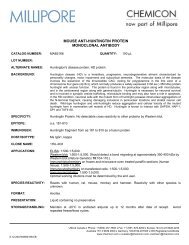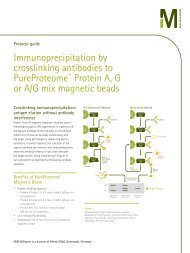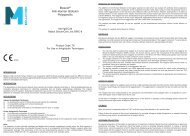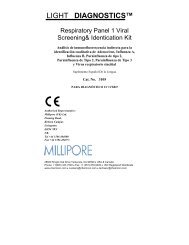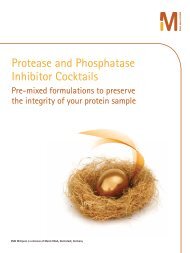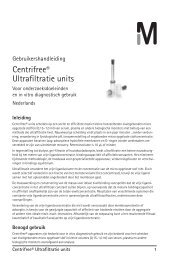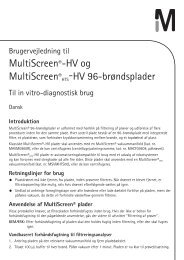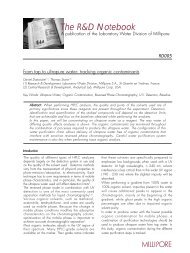MultiScreen Caco-2 assay system - Millipore
MultiScreen Caco-2 assay system - Millipore
MultiScreen Caco-2 assay system - Millipore
You also want an ePaper? Increase the reach of your titles
YUMPU automatically turns print PDFs into web optimized ePapers that Google loves.
Results<br />
Evaluation of Monolayer Integrity<br />
Prior to the start of all drug transport<br />
experiments, the TEER was measured<br />
in every well to confirm monolayer<br />
integrity. The TEER measurements for<br />
all experiments discussed in this<br />
section were typically in the range<br />
of 200 to 350 ohms x cm2 (data<br />
not shown). This range is indicative<br />
of successful formation of integral<br />
monolayers after 21 days of culture.<br />
The corresponding drug transport data<br />
confirm differentiated monolayers<br />
with tight junctions.<br />
Correlation of Drug Transport Rates<br />
to Human Absorption<br />
Historically, it has been shown that a<br />
sigmoidal relationship exists between<br />
drug absorption rates as measured<br />
with the in vitro <strong>Caco</strong>-2 model and<br />
human absorption. 8 Drug compounds<br />
representing active, passive, and<br />
4<br />
Equation 1<br />
The apparent permeability (Papp), in units of centimeters per second,<br />
can be calculated for <strong>Caco</strong>-2 drug transport <strong>assay</strong>s using the following<br />
equation8 :<br />
Papp =<br />
V A<br />
[drug] acceptor<br />
( ) • ( )<br />
Area • time<br />
[drug] initial, donor<br />
Where VA is the volume (in mL) in the acceptor well, Area is the surface<br />
area of the membrane (0.11 cm 2 for <strong>MultiScreen</strong> <strong>Caco</strong>-2 plate and 0.3 cm 2<br />
for the 24-well plate), and time is the total transport time in seconds. For<br />
radio-labeled drug transport experiments, the CPM units obtained from<br />
the Trilux Multiwell Plate Scintillation Counter were used directly for the<br />
drug acceptor and initial concentrations such that the formula becomes:<br />
Equation 2<br />
Papp =<br />
V A<br />
CPMacceptor<br />
( ) • ( )<br />
Area • time<br />
CPMinitial, donor<br />
efflux transporters were tested at<br />
ArQule, Inc. using the <strong>MultiScreen</strong><br />
<strong>Caco</strong>-2 <strong>assay</strong> <strong>system</strong>. 12 Each<br />
compound’s permeability rate was<br />
plotted against their percent human<br />
absorption values (Figure 3). The<br />
passive diffusion compounds included<br />
in this evaluation were carbamazepine,<br />
mannitol, penicillin, caffeine, buspirone,<br />
metoclopramide, haloperidol, promethazine,<br />
and imipramine. The active<br />
influx compounds were methotrexate,<br />
piroxicam, salicylic acid, and Gly-Sar.<br />
The efflux compounds included were<br />
loperamide, clomipramine, metolazone,<br />
alprenolol, timolol, metoprolol,<br />
digoxin, chlorpromazine, quinine,<br />
paclitaxel, thiacetazone, acebutolol,<br />
sulfasalazine, doxorubicin, and<br />
thioridazine. Using Statistica (Stat<br />
Soft Corporation, Tulsa, OK), a<br />
nonlinear regression curve,<br />
(% human absorption =100 x exp (a + b x Papp)/(1 + exp [a + b x Papp])<br />
Equation 2, was generated and<br />
provided a good fit to all of the data<br />
points. Statistical analysis of the curve<br />
suggested that there were no significant<br />
differences in fit based on<br />
whether the drug was absorbed<br />
actively, passively or effluxed (ANOVA<br />
F-test on single curve ranked residuals;<br />
p=0.33). Based on the curve fit,<br />
transport rates were typically > 1.0 x<br />
10 -5 cm/s and < 1.0 x 10 -6 for high<br />
and low permeable compounds,<br />
respectively. Intermediate compounds<br />
were estimated to have an upper limit<br />
of permeability of ~7.0 x 10 –6. This<br />
study demonstrated that the <strong>MultiScreen</strong><br />
<strong>Caco</strong>-2 <strong>assay</strong> <strong>system</strong> could correctly<br />
identify and classify the permeability<br />
properties of all 25 compounds tested.



